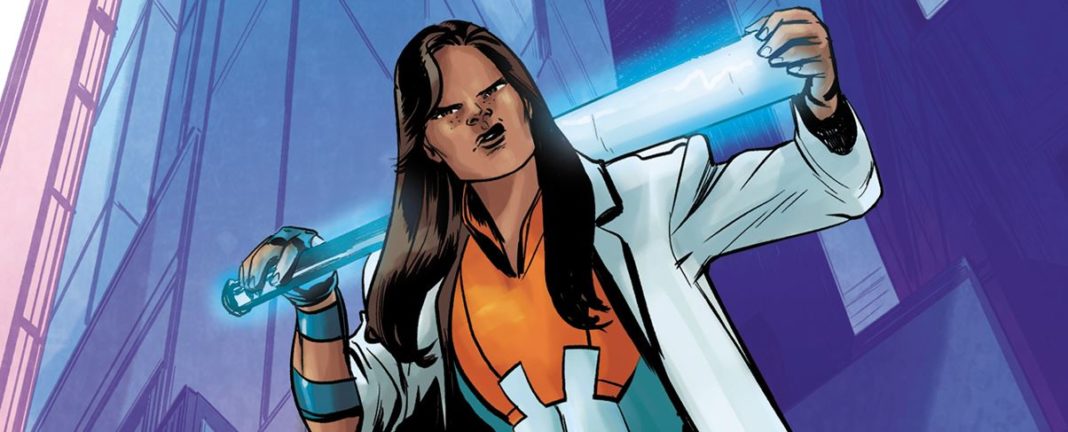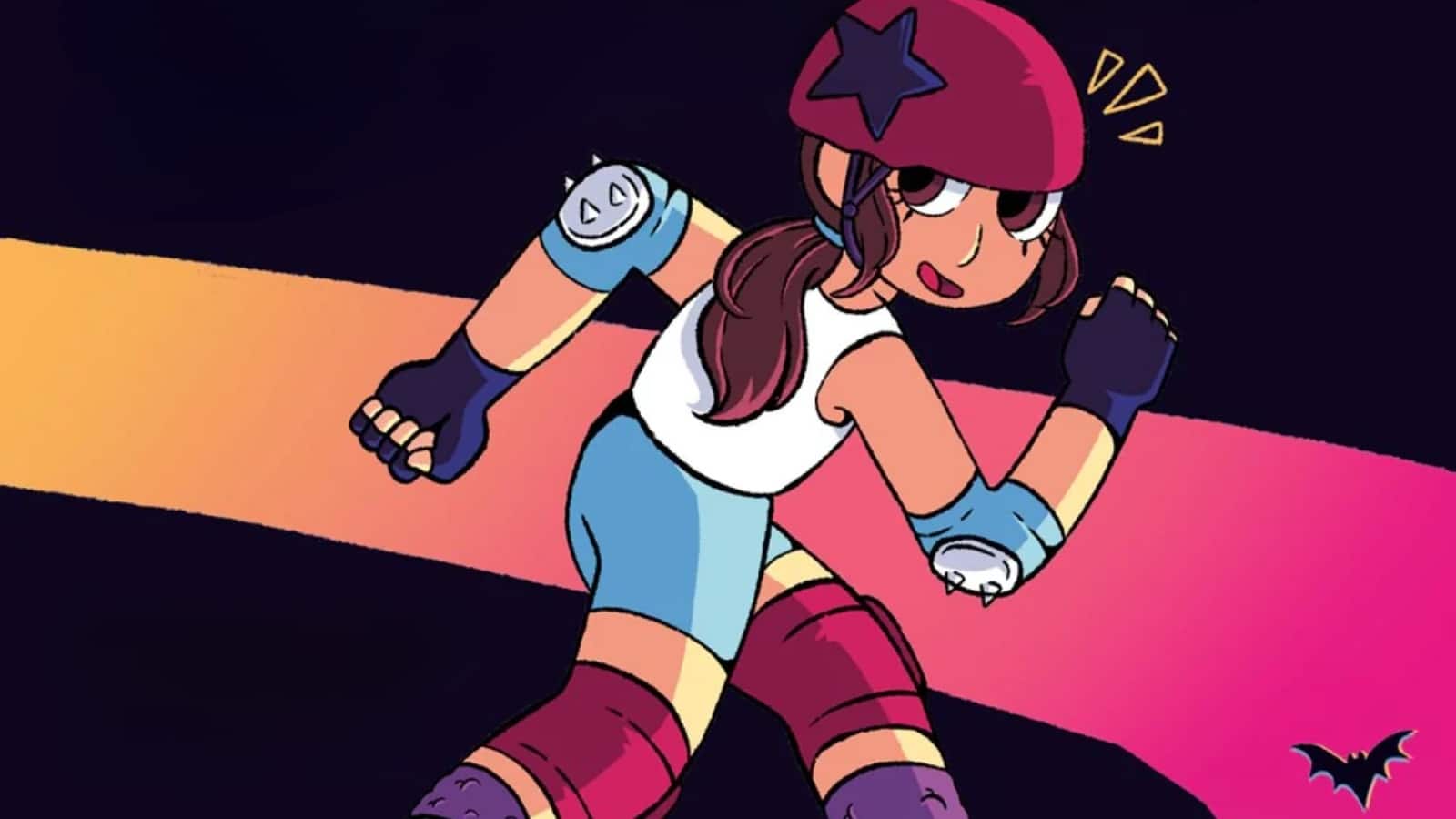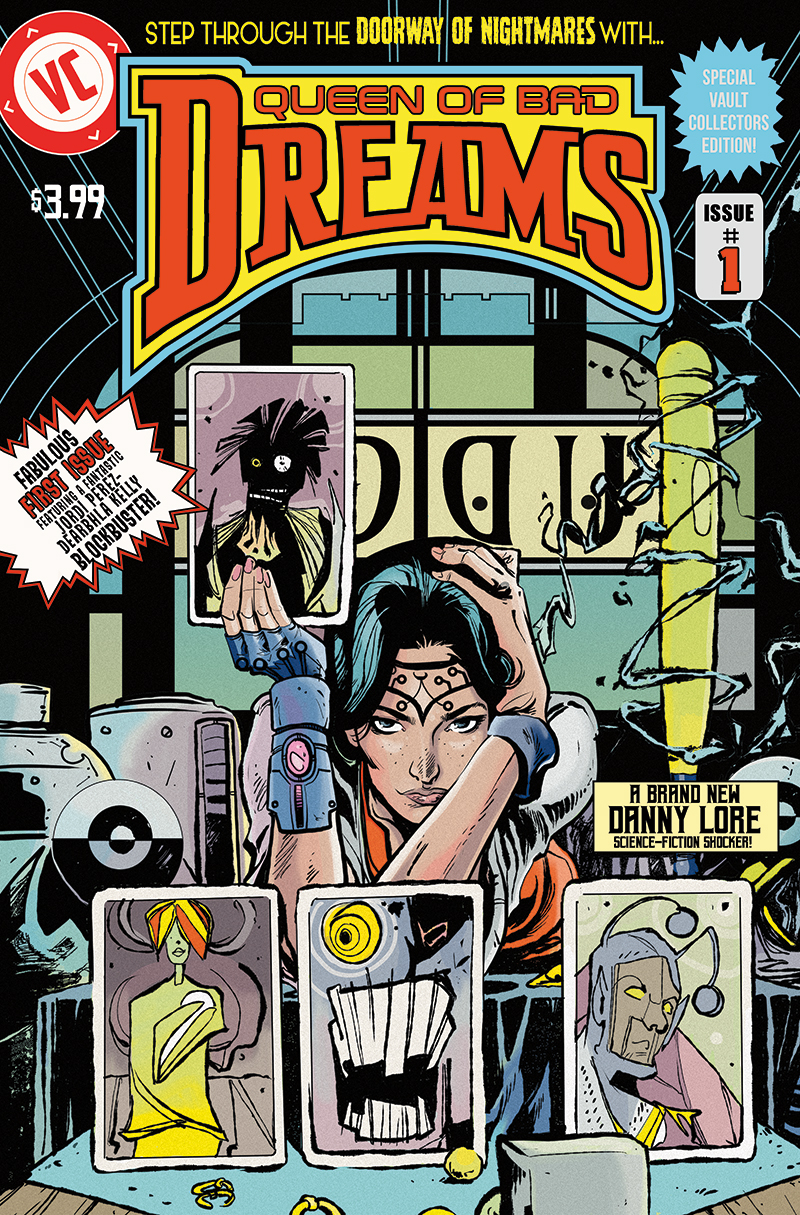
Science fiction as a platform for social commentary is no stranger to comics. Many have tried their hand at it given its allegorical nature and its wide berth for representation. Danny Lore (they/them), writer of the Vault comic Queen of Bad Dreams with art by Jordi Pérez, looks to sci-fi as a means to produce some genuinely dangerous visions of the future should our present not alter its course sooner rather than later. This makes them a writer that does not settle with merely taking readers out of their comfort zones. Instead, they look to confront readers with a possible reality borne out of our current social predicament.
Lore’s Queen of Bad Dreams imagines a world where the inhabitants of dreams, known as ‘figments,’ can escape their dreamers’ minds and exist in the conscious world. It’s up to Daher, a dream agent of sorts, to track down these figments and decide whether to reinsert them back into the dreamer’s mind or to allow them to remain in the real world. When the son of a powerful politician loses his figment, in the form of a black woman, Daher dives straight into an investigation that ends up revealing more about the politics of dreams, and nightmares, and just how deep we bury our moralities in our subconscious.
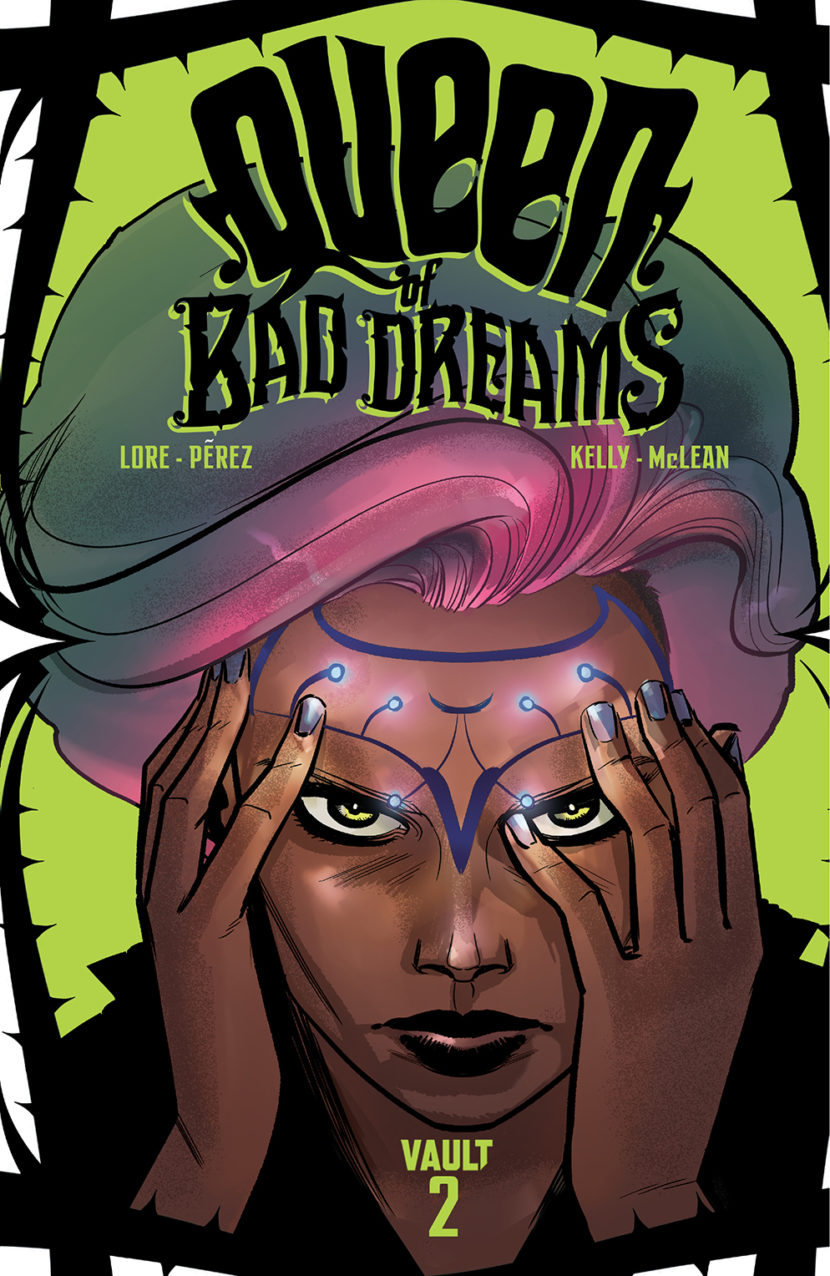
It is very clear Danny Lore has a lot to say as a black queer writer, as a comics creator, and as a social commentator by way of speculative fiction. Queen of Bad Dreams is an excellent example of how to start and enable important conversations about agency, identity, and comics and how they can reflect certain realities.
Lore has also produced prose fiction for FIYAH (for which they are also an acquiring editor), Podcastle, Nightlight, EFNIKS.com, among others. They are also the editor behind Vita Ayala’s and Emily Pearson’s The Wilds.
The Beat sat down with Danny Lore to talk about Queen of Bad Dreams, Sci-fi, and what it means to be a LGBTQ writer in the comics scene. Read on for what they had to say.
Ricardo Serrano: Reading Queen of Bad Dreams made me feel like I was reading a Phillip K. Dick book. It reminded me of his short story We Can Remember It For You Wholesale in parts (which inspired the movie Minority Report), but it also captures some of his more trippy and existential elements, such as those seen in Ubik. Was that something that informed your work?
Danny Lore: I think that’s the nicest thing anyone’s ever said to me about my work! I love A Scanner Darkly, his short stories and his novels. I love how he switches between the weird and the really not weird and still stay within the story’s logic. I like that play with between the weird and the mundane, the normal and the strange. He does that in A Scanner Darkly, with flashes into both worlds. It makes the story hit harder. I look to do that with Queen of Bad Dreams, take the normal and inform it with weirdness.
I’m also a fan of Cyberpunk and William Gibson. Neuromancer is one of my favorite books of all time. In fact, I always go back to Neuromancer and then Never Ending Story when I need inspiration. I think John Constantine is one of the coolest characters of all time, so Hellblazer’s up there too. Victor LaValle’s work in horror is spectacular and I’m definitely a fan.
Anyone who follows me on Twitter knows I love video games. I was born and bred on Final Fantasy and its epic summons and giant cities complete with hot dog stands. For Queen I thought a lot about Inception if it had taken that extra mile with the dreams. Sometimes dreams are normal, but other times there’s a big yellow monster running around. I looked at Paprika a lot for that, on what that extra mile could’ve been.
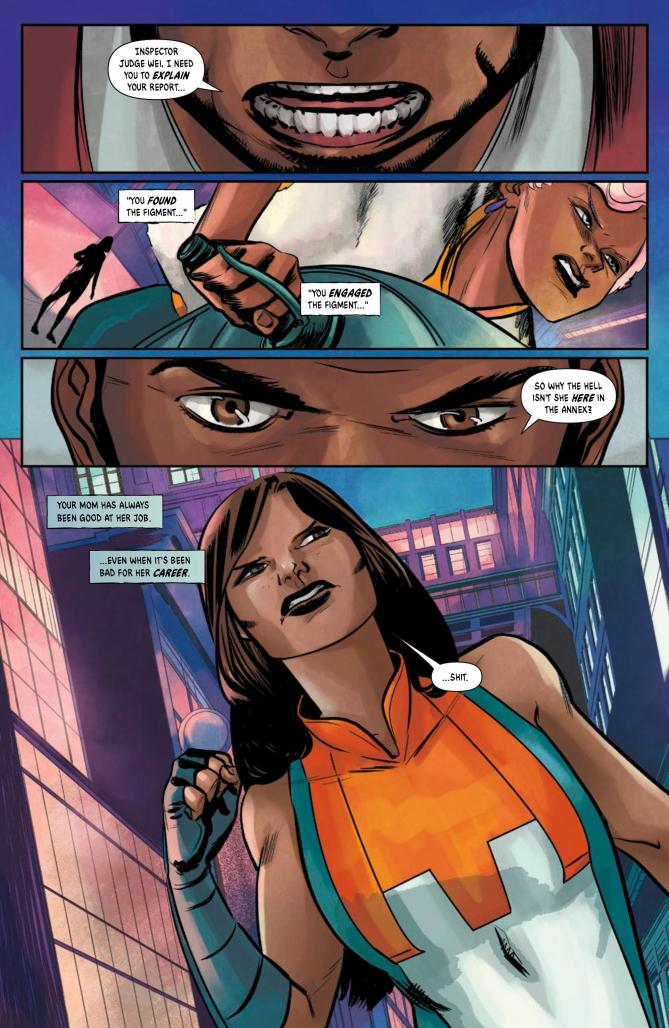
Serrano: The worldbuilding aspects behind Queen of Bad Dreams makes the story feel alive, as if it’s inhabited by real people. It’s really fleshed out. Did you go into the story thinking you really wanted to do worldbuilding or did it come organically as you were writing?
Lore: A bit of column A, a bit of column B. Honestly, it mostly came because this is such a team project. Adrian Wassel (editor-in-chief, Vault Comics) helped with nailing down the worldbuild, helping me tell the best version of the story. A lot of the bigger sci-fi concepts I had brought with me from the original story Queen is based on, which I wrote in prose. The agency behind the recovery of figments and some of the main characters were already there, especially the primary figment the story focuses on.
And then, Jordi Pérez and Dearbhla Kelly, on art and colors respectively, had so much input on the final look for so many things. At one point I think I gave a panel description that said “futuristic archive room.” That’s all I put on the script. When I get illustrated page back I find this intricate, detailed archives room that went above and beyond my initial description. So a lot goes back to this being a collective vision. Knowing I have a team that is excited with doing weirder stuff with the story, that they like experimenting with it, opens me up to include a lot more in the script.
Serrano: The way you address the story’s many messages and metaphors is refreshingly nuanced and authentic. It doesn’t feel preachy. It’s interwoven into the narrative. You tackle gender identities, for instance, as something that’s reached a state of normalcy and it works so well because you can say different things with it. How did you approach that?
Lore: I really wanted to be clear in terms of what needed to be stated and what was to be taken as a given. I had decided queerness was not going to be an issue. Non-binary identities were not going to be an issue either. I think this approach came to be mostly because there’s just so many things I’m dealing with in terms of identity, toxicity and brownness that I didn’t want gender to be a fight they needed to have. And this story could’ve been that, where queerness was a thing they needed to fight for. I guess I was more interested in telling a story about having agency as a brown person and how the world reacts to that. That’s the story I wanted to tell. I wanted some of the identities I interact with and that my friends have to not be the primary source of conflict. Plus, there’s a lot that can be done in the comics page to communicate ideas about gender, and it can be explicit. Some things we know by now, about queerness. Accepting them as normal opens up more storytelling possibilities.
Serrano: As a queer comics creator yourself, how do you navigate the comics scene? Have you seen it get worse, stuck, or do you see change?
Lore: I think we have our spaces. I have been fortunate enough to have support in the creative community and that’s because those spaces exist and are there for us. In my case, I also write prose and one of the magazines I’m involved with, FIYAH Magazine (which centers on black-only speculative fiction), is one such space. I think we can now see and recognize those spaces. Unfortunately, there are still a lot of people that want to see those spaces disappear, who don’t like or support them. So it’s a ‘one step back, one step forward’ scenario.
We are freer to recognize our spaces. And if anyone has a conniption about those spaces existing, honestly, screw them for having that conniption.
With the help of other writers and creators, I’ve been able to confront certain doubts about myself, which I’ve been facing since high school. That kind of support network helps. Immensely. I see improvement in being able to have that network. I mean, five years ago, I don’t know if Queen of Bad Dreams would’ve been published. I don’t know if it would’ve been accepted. And yet, that support network helped me continue and see this through.
Serrano: Thanks!
Lore: Thank you!
Danny Lore can be found on Twitter at @weredawgz. For more on Queen of Bad Dreams, check out The Beat’s preview of the second issue of the Vault series, found here.


